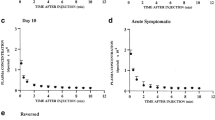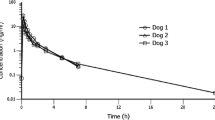Summary
The present study was performed to determine whether an opening of the blood-brain barrier (BBB) induced by intracarotid infusion of protamine sulphate necessarily leads to brain oedema and, if so, whether dixyrazine, a phenothiazine, can prevent the oedema. Evans blue albumin was used to detect BBB opening. Endogenous serum albumin was determined in CSF sampled before and after protamine infusion.
The brain specific gravity, a sensitive indicator of brain oedema, was determined one hour after intracarotid infusion of 5 or 10 mg protamine sulphate in 100 or 200 μl solvent in rats. Both doses opened the BBB and the CSF albumin was significantly increased (p<0.05 for 5 mg and p<0.01 for 10 mg protamine sulphate). However, only 10 mg protamine significantly reduced the specific gravity in the cerebral cortex and basal ganglia in the right (injected) hemisphere. Pretreatment with dixyrazine 10 mg/kg completely prevented the brain oedema and significantly reduced the albumin increase in CSF. We conclude that a) a moderate opening of BBB induced by 5 mg protamine sulphate does not lead to brain oedema and b) dixyrazine can prevent the brain oedema induced by 10 mg protamine sulphate.
Similar content being viewed by others
References
Baethmann A, Maier-Hauff K, Kempski O,et al (1988) Mediators of brain edema and secondary brain damage. Crit Care Med 16: 972–978
Baethmann A, Schürer L, Kempski O,et al (1990) Brain edema factors. In: Johansson BB, Owman Ch, Widner H (eds) Pathophysiology of the blood-brain barrier. Elsevier, Amsterdam New York Oxford, pp 357–368
Bothe HW, Bodsch W, Hossmann KA (1984) Relationship between specific gravity, water content and serum protein extravasation in various types of vasogenic brain edema. Acta Neuropath (Berl) 64: 37–42
Eisenberg HM, Barlow ChF, Lorenzo AV (1970) Effect of dexamethazone on altered brain vascular permeability. Arch Neurol 23: 18–22
Fredriksson K, Kalimo H, Westergren I,et al (1987) Blood-brain barrier leakage and brain edema in stroke/prone spontaneously hypertensive rats. Effect of chronic sympathectomy and low protein/high salt diet. Acta Neuropath (Berl) 74: 259–268
Fujiwara K, Nitsch K, Suzuki R,et al (1981) Factors in reproducibility of the gravimetric method for evaluation of edematous changes in the brain. Neurol Res 3: 345–361
Hardebo JE, Kåhrström J (1985) Endothelial negative surface charge areas and blood-barrier function. Acta Physiol Scand 125: 495–499
Johansson BB, Linder LE (1980) Do nitrous oxide and lidocaine modify the blood-brain barrier in acute hypertension in the rat? Acta Anaesth Scand 24: 65–68
Johansson BB, Linder LE (1981) Hypertension and brain oedema: an experimental study on acute and chronic hypertension in the rat. J Neurol Neurosurg Psychiatry 44: 402–406
Johansson BB (1981) Pharmacological modification of hypertensive blood/brain barrier opening. Acta Pharmacol Toxicol 48: 242–247
Johansson BB, Linder LE (1982) Specific gravity of brain tissue during maturation. Acta Neurol Scand 66: 575–581
Johansson BB, Auer LM, Linder LE (1982) Phenothiazine-mediated protection of the blood-brain barrier during acute hypertension. Stroke 13: 220–225
Johansson CE (1989) Potential for pharmacological manipulation of the blood-brain barrier. In: Neuwelt EA (eds) Implications of the blood-brain barrier and its manipulation, vol 1. Plenum, New York, pp 223–260
Klatzo I (1967) Neuropathological aspects of brain edema. J Neuropath 16: 1–13
Klatzo I, Wisniewski H, Steinvall O,et al (1967) Dynamics of cold injury edema. In: Klatzo I, Seitelberger F (eds) Brain edema. Springer, New York, pp 554–563
Kuroiva T, Cahn R, Juhler M,et al (1985) Role of extracellular proteins in the dynamics of vasogenic brain edema. Acta Neuropath (Berl) 66: 3–33
Laurell CB (1972) Electroimmuno assay. Scand J Clin Lab Invest 29: 21–37
Marmarou A, Tanaka K, Schulman K (1982) An improved gravimetric measure of cerebral edema. J Neurosurg 56: 246–253
Nagy Z, Peters H, Huttner I (1981) Endothelial surface charge: Blood-barrier opening to horseradish peroxidase induced by the polycation protamine sulphate. Acta Neuropath (Berl) 7: 7–9
Nelson SR, Mantz ML, Maxwell JA (1971) Use of specific gravity in the measurement of cerebral edema. J Appl Physiol 30: 268–371
Petito CK, Schefer JA, Plum F (1976) The blood-brain barrier in experimental seizures. In: Pappius HM, Feindel W (eds) Dynamics of brain edema. Springer, Berlin Heidelberg New York, pp 38–42
Westergren I, Johansson BB (1990) Albumin content in brain and CSF after intracarotid infusion of protamine sulfate: A longitudinal study. Exp Neurol 107: 192–196
Westergren I, Johansson BB (1991) Changes in physiological parameters of rat cerebrospinal fluid during chronic sampling. Brain Res Bull 26: in press
Author information
Authors and Affiliations
Rights and permissions
About this article
Cite this article
Westergren, I., Johansson, B.B. Dixyrazine, a phenothiazine derivate, can prevent brain oedema induced by intracarotid injection of protamine sulphate. Acta neurochir 113, 171–175 (1991). https://doi.org/10.1007/BF01403203
Issue Date:
DOI: https://doi.org/10.1007/BF01403203




